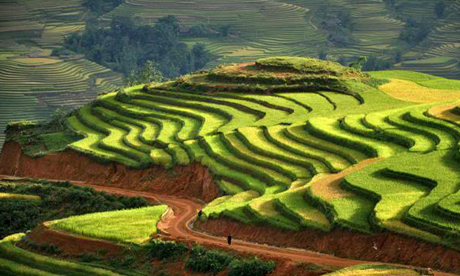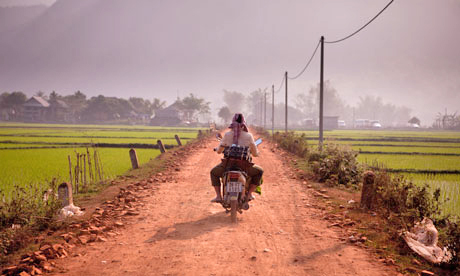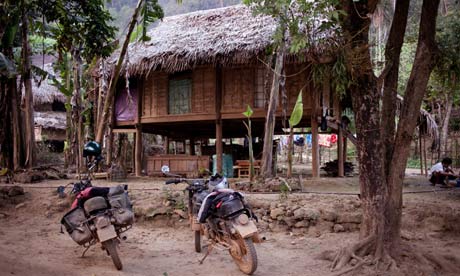It was more like a hamlet than a village. A simple collection of stilted wooden houses perched on the side of a mountain overlooking seemingly-endless rows of rice terraces, but even after a long and tiring day on the back of a motorbike passing through startling terrain it was hard not to be caught breathless by its isolation and beauty in the twilight.
 Rows of rice terraces are a continual feature on any ride through northern Vietnam.
Rows of rice terraces are a continual feature on any ride through northern Vietnam.
The primitive village of Ban Hieu is inaccessible except by motorbike or on foot – it's up a long, steep and winding two-metre-wide dirt path flanked on one side by a sheer drop into the paddy fields far below. It was precisely the reason I had set off the previous day along paths once used by the Vietcong to
deliver weapons and supplies to the armies fighting in the south during the Vietnam war.
The Ho Chi Minh Trail has always been the stuff of legends, a seemingly endless number of backwater paths and trails that started near Hanoi and ran almost 1,000 miles down the length of the country, crossing into Laos at several points, and ending near
Saigon (today's Ho Chi Minh City) where it deposited weapons into the hands of the communist guerrillas fighting against US and Southern Vietnamese forces.
While most visitors to Vietnam travel the well-worn coastal road, I had set out the day before from
Hanoi, along with a friend and our mechanic/guide, on the back of three sturdy Russian Minsks, heading south on what would be a three-day
bike trip following less well-developed and at times almost non-existent roads. (This would allow me to do part of the northern section, though not enough time to complete the whole route, which takes upwards of 14 days.)
 A local rides through paddy fields in Hoa Binh province, northern Vietnam.
A local rides through paddy fields in Hoa Binh province, northern Vietnam.
With little chance to dwell on the fall and already far from civilization, I had simply but shakily climbed back on the bike and, following Dang Van Diep, our smiling, non-English-speaking mechanic, soldiered on.
An hour later the fall was already far from my mind as I emerged for the first time from a patch of mountain fog to look down upon the vast, green landscape of rural Vietnam stretching out before me.
The view would repeat itself regularly over the next few days (and would never cease to thrill) as our small convoy climbed and descended thin mountain paths, crossed through knee-deep rivers, and rode through dozens of isolated villages of smiling and waving children. All the while we were flanked by miles upon miles of muddy rice paddies filled with young and old women cultivating the land by hand as they and their ancestors have done for centuries.
I soon found a simple but beautiful monotony in riding through these lush green areas, with long hours between stops passing in a meditative blink of the eye. Yet by the end of each day, as the strain of holding firm to the throttle as the bikes bounced over rock and skidded through mud, thoughts of that night's accommodation slowly crept into our minds.
 The Russian-made motorbikes outside the homestay in the village of Ban Hieu.
The Russian-made motorbikes outside the homestay in the village of Ban Hieu.
We spent the first night in Mai Chau, a scenic village without roads 135km from Hanoi that is quickly being discovered by tourists looking for somewhere off the beaten path.. That night, after 10 hours on the bikes, we arrived at the truly isolated Ban Hieu.
A village of a few dozen families, an hour by motorbike from the nearest community with a shop, and inaccessible by car, it felt like a forgotten land. The manmade rice terraces – irrigated by intricate bamboo piping snaking down the hillside – and other human intrusions all felt in harmony with nature, and in the miles upon miles of land spread out before us, no city, town, or even single human dwelling was in sight.
Our smiling hosts were already pouring hot water for us and preparing food and beds for the night as I returned.
The following day at dawn we started our journey back north, reaching the noisy and crowded streets of Hanoi by nightfall. Despite one bad fall, aching limbs and over 300-plus miles of dirt trails on the back of a relic of the Soviet Union, it was hard not to turn the bike around and head back out to continue down the trail southwards.
• Hire motorbikes and all-inclusive organized tours can be arranged through tour companies such as Ride Ho Chi Minh Trail (
www.ridehochiminhtrail.com).
Recommended tours:
Taste of Ho Chi Minh Trail
Motorcycling the Ho Chi Minh Trail - Half Challenge
Source: guardian.co.uk






